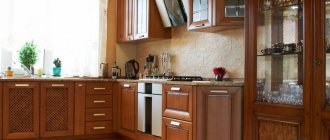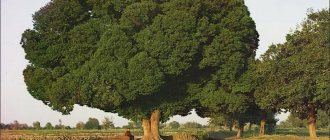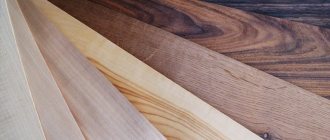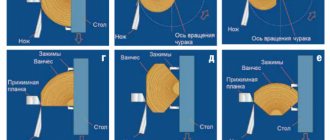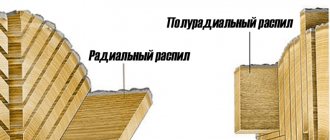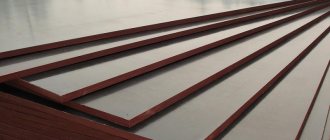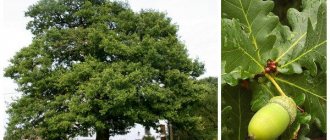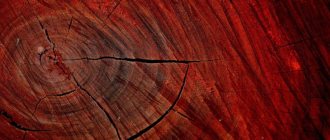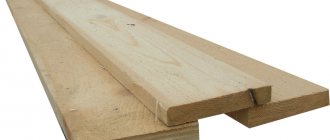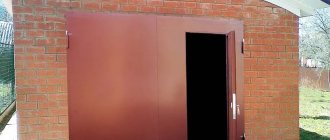Classification
Depending on the method of obtaining the material, veneer is distinguished:
- peeled;
- planed;
- sawn
Peeled veneer
Produced on special machines using the peeling method. Its thickness is 0.1-10 mm. This is a cheap veneer because it is produced in the most cost-effective way.
Birch veneer
To begin with, prepare the workpiece - the tree trunk is cleared of branches, twigs, etc. Then they place it in the machine. Next, the initial processing of the trunk is performed with a cutter: the bark is removed and the workpiece is leveled along the length. After this, a layer of veneer of the required thickness is removed along the entire length of the trunk at the same time.
The resulting semi-finished product is sorted by quality, appearance, etc. This type of veneer, compared to others, is not beautiful enough. Therefore, so that it can be glued to doors, it is processed, for example, painted or subjected to hot printing.
Sliced veneer
It is obtained by planing bars perpendicular to the wood fibers on veneer planing machines, in contrast to peeled wood, which is obtained by cutting the wood layer from a rotating block.
Production of peeled and sliced veneer
Veneer is made from deciduous and coniferous wood such as birch, maple, pear, elm, oak, linden, mahogany, etc. The thickness of the material obtained in this way is 0.2-0.5 mm.
Beautiful veneer for interior and exterior doors is made from twisted wood. In a twisted tree, the fibers inside the trunk do not run smoothly, but are intertwined, forming patterns in the form of knots, bunches, etc.
When producing veneer from such a blank, a layer is removed simultaneously along, across and at an angle to the fibers. This gives a beautiful pearlescent shine to the material. Karelian birch and sugar maple wood are valuable for such veneer. If you stick such veneer on ordinary wooden doors, they will look much richer and more beautiful.
Sawn veneer
It is made by cutting blanks. A high-quality product with a thickness of 0.1-1mm is obtained. However, this type of production is the most uneconomical, since about 60% of the wooden workpiece goes into sawdust.
Based on the wood texture, veneers are distinguished:
- radial (the pattern of annual layers consists of parallel lines that are located along the entire plane);
- semi-radial (the pattern of annual layers consists of parallel lines that occupy at least ¾ of the plane);
- tangential (annual layers create a pattern of cones, angles or curves);
- tangential-end (annual lines create closed curved lines).
According to the material used for the production of veneer, they are distinguished:
- natural;
- fine line;
- multi-veneer;
- eco-veneer
Natural veneer
Made from natural solid tree trunk. At the same time, the structure of the tree is preserved. The cost of natural material is in the middle price category.
Fine-line veneer
It is also made from inexpensive and fast-growing natural wood, but has a highly porous structure. The appearance resembles plastic. With the help of staining, fine-line veneer can imitate natural veneer made from expensive wood. This material is often used for finishing interior doors. It is made as follows. First, natural veneer is produced. Next, the veneer sheets are dried, sorted and painted in a specific color. After this, the sheets need to be glued together.
Fine-line veneer
As a result, the resulting block of veneer sheets is sent under the press. Very thin sheets of fine-line veneer are cut from the finished dried compressed block and glued to the surface to be decorated. In terms of its composition, it consists of 92-94% natural wood. The rest is glue and dye.
Multispon
Refers to a reconstructed type of veneer, like fine line. Geometric patterns are most often applied to its surface.
Eco-veneer
It is a polymer film with the addition of wood fibers. Its surface imitates the surface of natural wood. It is resistant to abrasion, temperature changes and humidity. Veneered doors using eco-veneer are durable and do not lose their performance characteristics for a long time.
What is veneer
This is a material obtained by longitudinally dividing natural wood into thin sheets or strips. For their production, cuts of domestic woody plants (coniferous and hardwood veneer), as well as imported exotic woody plants, are used.
Veneer is usually divided into decorative and construction.
- Veneer is made by peeling, cutting, cutting or using special methods.
- The thickness of peeled veneer is 0.6–3.5 mm.
- It is produced by cutting on horizontal saws with high wood losses and low yield of finished products.
Due to the physical properties of wood, it is processed without prior plasticization.
Cutting knives have a thickness of 0.8–4 mm. Cutting produces decorative veneer. The pattern of the veneer can be influenced by placing the wood at an angle during the cutting process. The thickness of this veneer is 0.6-0.8 mm.
Characteristics
TECHNICAL DATA SHEET KAINDLFURNIERTE E1 (veneered)
Application area:
Veneered chipboard (MDF) has various applications in furniture production and interior decoration, but without a load-bearing function.
Design:
- valuable wood veneer
- load-bearing slab
- valuable wood veneer
Surface: valuable wood veneer.
Dimensions:
| Thickness | Carrier plate | Dimensions |
| 9/ 13/ 16/ 19/ 23/ 26/ 29/ 39 mm | Chipboard R2 | 2800 x 2070 mm / cross veneer possible |
| 9/ 16/ 19/ 26 mm | Special sizes: 3200 x 2070 mm 3600 x 2070 mm other sizes on request | |
| 4/ 6/ 9/ 13/ 17/ 19/ 23/ 26/ 29/ 39 mm | MDF | 2800 x 2070 mm / cross veneer possible |
| 16/ 19/ 23/ 26/ 29mm | Joiner board | 2800 x 2060 mm |
| 16/ 19/ 2530mm | Birch plywood | 2500 x 1250 mm 3000 x 1500 mm |
The load-bearing slabs correspond to emission class E1
general information
| Options | Unit | Test Method | |
| Anti-scratch resistance | Coeff. 3 | Degree 2* /2N | EN 438-2:2005 |
| Stain resistance | Degree5 Degree 3 | Group 1+2 without visible change Group 3 moderate change in gloss and/or color | EN 438-2:2005 |
| Behavior towards the glow of a cigarette | Degree 3 | moderate change in gloss level and/or moderate brown spots | EN 438-2:2005 |
| Surface defects | sq.mm/sq.m. mm/sq.m | Dirt, stains Fibers, hair and scratches | EN 438-2:2005 |
QUALITY DESCRIPTION: valuable wood veneer
Quality 1A: veneered quality A, but sorted according to customer requirements:
Definition of terms:
1. Frieze: calm - without flower
2. Figure: flower – with veins
3. Contrasting stripes: half flower - half with veins
4. Barrel: - minimum 6 slabs with veneer from the same trunk
- each barrel is individually packaged
- a trunk reversal is formed by a combination of figures; only beech and oak allow the trunk to open without a flower (real rift).
Sheet width: production according to specified board widths, with the exception of the first and last sheet, tolerance +/- 2mm. Price on request
Quality A: face veneer with different structures (no flower, half flower, flower), mostly pure or having only the usual wood characteristics of face veneer (for example, light sugar in Canadian maple), without residual sheets.
Quality B: uniform color, different structures, used for the visible sides of furniture cabinets or the reverse side of the fronts, minor wood characteristics, there are residual sheets with similar structures.
Quality C: uniform color, different structures, used as the front side of cabinets or the back side of fronts, minor wood characteristics, there are residual sheets with similar structures.
Quality GZ stabilizing layer – veneer
Veneer on the reverse side - at the choice of the factory
Small opening defects and crumbled areas, sapwood, accretion, etc.
Quality KP stabilizing layer – paper
Only for dimensions 2800 x 2070 mm
Slight warping is possible, we recommend using power paper only from a thickness of 16 mm
Quality A/B-LA on the front side there are veneers and quality A and B, on the back side B and C.
The product requires less sorting costs and can in any case be used for cabinets and interior decoration
Separate sections can also be used for fronts.
Qualities from 1A to KR can be combined in any configuration!
SURFACE: valuable wood veneer.
Feature: at the customer's request, several types of veneer shell production are possible (symmetrical, longitudinal, checkerboard, inverted).
Seam gluing: all veneer strips are glued end to end to ensure perfect quality of the veneer shell.
STORAGE RECOMMENDATIONS:
Veneered boards KAINDL Veneered E1 must always be stored horizontally in stacks over the entire area of the board, in closed warehouses, avoiding exposure to moisture and direct sunlight and UV rays.
TREATMENT:
KAINDL boards E1 veneer panels can be processed using conventional woodworking machines.
The surface of the veneer boards is processed with sanding paper K 80.
To remove possible residues of glue, grease, oil, etc. It is recommended to carry out final sanding before impregnation and varnishing. In any case, it is necessary to make a control sample of veneer with a treated surface (impregnation, varnishing, oil, etc.) in order to avoid possible surface defects.
If the above recommendations are not followed, subsequent claims will not be accepted.
Price
The price of veneer consists of the following factors:
- Features of production, labor costs.
- Presence and quantity of waste.
- The complexity of the equipment used.
- The width of the sheet, which depends on the thickness of the log.
- Types of wood.
- Valuables, rarities of raw materials.
The most expensive is sawn, the cheapest is peeled. Planed is in the middle price category. It comes in different varieties, so the price range for it is wide. Natural veneer is more expensive than artificial veneer.
Advantages and disadvantages
Veneer is a thin section of natural wood, not exceeding 3mm in thickness. It is widely used in the production of modern furniture, musical instruments, and is also used as a finishing material in creating fashionable interiors. The popularity of this natural material is due to the optimal combination of price and attractive appearance of the finished products. To make it easier to make a choice, we will analyze all the pros and cons that veneer furniture has.
The advantages of the material are as follows:
- variety of colors and textures. Various types of wood are used for production: from classic pine to the most expensive varieties;
- it is a natural, environmentally friendly material. Veneer is a covering made from natural wood;
- ease of processing allows the use of veneered blanks for products of various shapes and configurations;
- relatively low cost. Furniture made from veneer is much cheaper than products made from solid wood, which makes it more accessible;
- excellent appearance - high-quality products have the correct selection of patterns, beautiful texture, which give veneered furniture a wonderful appearance;
- practicality, resistance of facades to temperature changes and high humidity. Veneer facades are not subject to cracking or deformation as a result of exposure to external factors.
The material also has disadvantages:
- veneer coating is afraid of direct sunlight: under their influence it can change color;
- choosing a pattern at the joints can be difficult, because each sheet has its own unique pattern;
- easy to care for, eliminates the use of chemical cleaners that can damage the surface;
- products made from expensive veneer options (oak, ash, beech) are not cheap.
Veneer manufacturing process
To obtain veneer, the log is cut into boards with a circular saw or chain saw. The length of the board for peeling is 1.3–2.5 m, for cutting - 2–7 m. Longitudinal division depends on the type of wood and its pattern.
These are simple divisions, halves, quarters and paired prisms for larger diameters. Radial layers are cut from prisms.
- The produced veneer layers must be dried, as they have high humidity. Dried in roller or belt dryers. Some types dry naturally indoors at normal temperatures.
- The dried ones are sorted into defect-free layers, defective and unformatted pieces. Defects are eliminated by gluing cracks or gluing patches. Shapeless pieces of veneer are given the shape of a rectangle.
- Planed layers of veneer are stacked into bundles. They are stored without access to daylight, so they do not change color due to ultraviolet radiation. Veneer sheets are stacked on top of each other without alternation.
The back side of the veneer is the area of the veneer that touches the knife when peeling or cutting, and often develops longitudinal cracks and torn grains.
It has a lower quality and a rougher surface. The veneer face is the area of the veneer that touches the press bar of the machine for slicing or peeling (pressing).
It is of higher quality and has better surface roughness. A pack of veneer blanks is a semi-finished product that is created by dividing a pack of veneer into the dimensions necessary to form joints.
Cons and pros
In appearance, doors with veneer are very difficult to distinguish from analogues made of wood, since they are covered with a natural cut of wood.
Such doors have many advantages:
- The composition of the product is 99% natural, since it includes solid wood and a cut of valuable wood on the outside.
- Doors with veneer are made from environmentally friendly materials, so they are often used not only for bedrooms or living rooms, but also for children's rooms.
- The attractive appearance of the product is achieved through the use of natural wood, which is characterized by an original and unique print and texture.
Wooden doors with veneer allow you to create a good indoor microclimate. They perfectly allow air to pass through micropores. The lightness of veneered models allows them to be installed even on very thin walls. If the doors are installed correctly, they may sag in rare cases. A good combination of product quality and price. If you compare the cost of a veneered and wooden model, then the veneered version is much cheaper
If a model with natural veneer is also expensive, then you can pay attention to options with eco-veneer or other artificial coating. Models with veneer very often convey the texture of valuable wood. Cherry, pine, wenge, mahogany or ash veneer looks beautiful
Expensive tree species include black walnut and madrone.
- Veneered models can be repaired if the canvas is damaged during transportation or use. It is necessary to use a special composition for coloring the veneer or polish the damaged area.
- A product with veneer is characterized by excellent sound insulation properties, as well as the ability to retain heat excellently, if we talk about options made from solid pine.
- Modern manufacturers offer a wide range of veneered doors, from which you can choose not only the material, but also the color design and the required sizes. The doors are presented in natural colors. To give veneer depth of color, it is often stained.
Doors with veneer also have some disadvantages that you should familiarize yourself with before choosing doors:
- Natural materials are always expensive, so veneered models are expensive. The price of doors is also influenced by the manufacturer's reputation.
- Natural veneer is practically no different from artificial veneer, which allows scammers to pass off low-quality veneer as natural.
- To ensure long-term operation of the product, careful care is required. To clean doors, you should use special wax-based products.
To make a laminated door, a special laminate film is used. It perfectly conveys the texture of the array. Of course, such products are distinguished by their affordable cost, increased wear resistance and reliable protection from moisture.
Varieties
Veneered furniture is made from materials of varying quality and production methods. The price category of furniture depends on the type of veneer. There are the following types of veneer of natural origin used for furniture production:
- peeled;
- planed;
- sawn
Peeled
sawn
Planed
Natural peeled veneer is the most common and affordable type of veneer, with a thickness of 0.1 to 10 mm. Depending on the quality of the wood and compliance with the production technology, such veneer may be as good as planed veneer. It preserves the natural texture, unique pattern of wood, and has excellent aesthetic qualities.
Sliced veneer is used primarily in furniture production. Valuable wood species are used in its production. It is characterized by richness and variety of patterns and textures, which is achieved thanks to the production method. Wood blanks can be planed in different directions, at different angles, achieving unique, original natural patterns.
Sawn veneer is the first type of material that began to be produced back in the 19th century. It is of high quality and is not cheap. Today it is not made on an industrial scale, but is used to create musical instruments, inlays, interior decoration, expensive parquet floors and individual sets of custom-made furniture.
Modern varieties of veneer, subtypes of natural material, include:
- multi-veneer;
- fan line.
Multispon
Fan-line
Multispon is made from natural wood of various species, without the goal of preserving the natural pattern. This type of material is limitless in its colors, textures, and has a palette of rich wood patterns. Geometric shapes or any other design pattern can be depicted on its surface.
Fine-line is made from inexpensive species of fast-growing trees using several technological combinations:
- peeling and drying;
- painting and gluing;
- pressing and secondary planing or peeling.
The sequence of the above actions allows you to create a material of the required texture, pattern, structure and color. Fine-line often imitates the natural veneer of expensive types of wood. This type is less durable, has increased fragility and porosity.
There is a distinction between artificial veneer, which is a plastic film (PVC) with an imitation of wood pattern. A modern version of artificial veneer for furniture is eco-veneer. This material is made from multilayer polypropylene.
What types of wood veneer are there?
Sliced veneer
As for this product group, it has the following differences:
- sheets are produced on special veneer cutting equipment, characterized by high precision and cleanliness of processing;
- product thickness can vary from 0.2 to 5 millimeters, which is sufficient for most uses;
- This production method is used when working with valuable wood species, as it allows their structure to be presented in the most favorable light. The most commonly used wood for work is oak, walnut, beech, Karelian birch, acacia, ash, yew and much more.
You should remember one simple rule: the thicker the veneer, the more reliable it is, so you shouldn’t save money and buy the thinnest options
Peeled veneer
The production of wood veneer using this technology has the following features:
- The production process is very simple: logs are cut into pieces of small width, after which they are cut into sheets of small thickness using a special knife. The quality of this option is noticeably lower than the first, but the cost is lower, so it is the most popular;
- The following types of wood are most often used for work: pine, birch, alder and oak;
- The thickness of the finished elements can be from 0.1 to 10 millimeters, which allows you to choose the optimal solution for any type of work.
Sawn veneer
As for this type of product, the following can be noted about it:
- products are produced on special machines that cut the block layer by layer, due to the large amount of chips that are formed during work, the cost of the material is high;
- the thickness of the lamellas, which is what the finished elements are called, can range from 1 to 10 mm;
- Products of this type are of particularly high quality, so they are very often used in the production of musical instruments; they can also be used in the interior and in the manufacture of furniture; such surfaces practically do not require additional processing.
It is important to choose the option that is best suited in a given situation, and if the manufacturer has recommendations for use or special instructions for carrying out work, then all requirements must be followed in order to obtain a guaranteed high result. One simple rule should be remembered: the thicker the veneer, the more reliable it is, so you should not save money and purchase the thinnest options
Veneer is one of the materials whose popularity never decreases; moreover, with rising wood prices, the demand for this option will be even greater
One simple rule should be remembered: the thicker the veneer, the more reliable it is, so you should not save money and purchase the thinnest options. Veneer is one of the materials whose popularity never decreases; moreover, with rising wood prices, the demand for this option will be even greater.
Types of veneer
Sliced veneer is veneer obtained by cutting a block longitudinally or transversely to the grain. Peeled veneer is a veneer of a certain thickness obtained by peeling a cutout.
Eccentric cut-out sanding is used to make decorative veneer joints.
- Log veneer is a set in which layers of a single board, log or prism are stored as they were made in a row.
- Marquetry is an ornamental veneer made primarily by hand (or on a special embossing device) of various shapes and motifs for the purpose of decorating and presenting the woody plants used.
- Mosaic is a combination of regular, repeating patterns used to create ceilings, floors and tiles from agglomerated materials.
Interior doors made of veneered MDF
MDF and veneer are those materials that, due to their properties, have become the most successful option for replacing natural wood, and when they are combined, objects are obtained of excellent quality and are not inferior to the natural prototype.
In order to produce veneered MDF doors, a special technology using high pressure and temperature is used. It is this that ensures such properties of the material as reliability, practicality and durability. Due to the very high compaction density, such doors are moisture resistant and practically do not deform. Compared to wooden models, they are more functional. Their advantages: light weight, aesthetic appearance and long service life.
Veneer is a modern finishing material, which has recently become quite widely used in various finishing and carpentry works. Over the years, it has managed to prove itself only from the best side, and to this day it is the most widespread and in demand.
Tips for selection and care
When choosing veneered furniture, the following main criteria are important:
- price;
- environmental friendliness;
- durability and wear resistance;
- aesthetic qualities;
- maintainability.
An important point is the design of the room. Modern artificial materials are excellent for implementing bold design projects, providing an unlimited range of shades, textures, and patterns. Natural material is perfect for classic room designs, combining the beauty of natural wood and the environmental friendliness of natural materials.
Natural materials require careful care without the use of aggressive chemicals.
It is enough to wipe such surfaces with a cotton rag using a soap solution. Artificial analogues are not so capricious to care for. But it is necessary to use cleaning products without abrasives, alkalis, or solvents.
Colors
The colors of the slabs are offered in a wide range, so everyone can find something that meets their design needs. You can choose transparent or translucent slabs, on which a lace pattern is applied. These slabs imitate glass and stained glass; such unusual decor is often used as a separate component that complements the overall interior. The dense monochrome coating of veneered MDF boards is presented in pastel and bright colors. If you need a light facade, you can safely choose panels with this design. The range of solutions can reach 200 options, while the execution can be either smooth or textured.
It is worth noting that white slabs are available in several shades, which allows you to achieve the ideal design solution and interior decoration. Of course, slabs made from solid wood, metal or natural stone are in great demand. This effect is created using films, patination, brushing and embossing.
Stone veneer - reality or fiction?
Stone veneers are very thin sheets of slate stone. The average sheet thickness is 2 millimeters. The plates are connected to each other using fiberglass resin.
This is truly a unique and very original coating, characterized by maximum naturalness. They finish drywall, chipboard or MDF with it. This is a beautiful and very unusual material. Depending on lighting conditions, it can change shade, and each sheet follows the unique pattern of slate and natural roughness.
If you want to order surface veneering or buy products already covered with veneer, you can contact the Bobry factory in Krasnodar. Our specialists will definitely help you. We are waiting for your orders!
SEE ALSO: What are the differences between artificial veneer • Advantages of natural veneer • What is veneering?
Advantages and disadvantages
The kitchen is a place where furniture is exposed to special negative influences: temperature changes, grease stains, and soot deposits certainly accompany the cooking process. Housewives try to select a set that will withstand all unfavorable factors as firmly as possible and will not deteriorate or become deformed.
- Durability. Lacquered veneered facades not only look stylish, but are also very wear-resistant and durable. This surface is not easy to scratch, it is impact-resistant, and is not afraid of moisture, steam, or direct sunlight.
- Maintainability. Furniture can be easily restored even at home. If scratches appear, they can be sanded; if there are chips, they can be eliminated using the same veneer patches. As for film or plastic, such surfaces cannot be restored after serious damage.
- Acceptable price. Compared to solid wood, kitchens made of veneer are much cheaper, and in terms of characteristics, veneer is significantly ahead of its expensive competitor.
- Stylish design. Veneered fronts look great in both small and small kitchens, as they look elegant and less bulky. The plasticity of the veneer material allows you to create unique shapes, so the furniture fits into classic and modern interiors. It is also possible to choose any color and texture you like, and make the surface matte or glossy. Veneer combines harmoniously with glass, acrylic, metal or plastic.
- Easy care. Sheets of natural wood require the same care as solid wood. Stains can be easily removed with a damp cloth or sponge. Under no circumstances should you use aggressive household chemicals containing abrasive particles to avoid damaging the surface. It is advisable to use a simple soap solution or special furniture sprays. They will help maintain shine and attractive appearance for a long time. Designers recommend choosing lighter shades, since stains and dust are much more noticeable on dark brown, black, and dark blue facades.
- Environmental friendliness. The kitchen is the place where a person spends most of his time, so the quality of the material should come first. Veneered facades, unlike film or plastic, do not pose a threat to human health, since no harmful substances or chemical compounds are used in production.
Veneered facades are strong, durable and do not deform.
Veneer varnishing provides additional protection for the façade
- The quality of a kitchen set is difficult to assess at first glance. Only during operation can one understand how conscientiously the manufacturer produced the veneer. If raw materials were used in the work, then over time the facades may become deformed, and the veneer may peel off from the substrate. When purchasing a set, you should give preference to reputable companies that provide a guarantee on the purchased furniture. However, it is necessary to adhere to certain rules for caring for the headset, otherwise the manufacturer may void the warranty if the instructions are not followed.
- Unfortunately, like any wood, veneered wood is susceptible to the negative effects of ultraviolet rays. Over time, facades may fade, for example, the white color may turn gray. Sanding and refinishing the coating will help solve the problem. Plus, this is a good way to change up your kitchen design a little and experiment with shades. For small kitchens it is recommended to choose light colors; in large ones you can combine different colors.
- The price of veneer is significantly higher than products made of plastic or vinyl film coating. Increased consumer demand and wood shortages also lead to a constant and systematic increase in the cost of furniture from year to year.
Veneered panels are often combined with others, for example, with film or enamel
Differences between artificial and natural materials
What is the difference between fine-line veneer, multi-veneer, eco-veneer and natural planed material? The main differences between artificial and natural veneer:
- all sheets of artificial material of a specific article will have an exact match of color, texture, and picture. This makes it possible to make products that are perfect in color, without inclusions or knots, and with complete matching of wood patterns. Artificial veneer sheets are interchangeable, so such products can be easily repaired or complemented with other furniture, and the color match will be perfect;
- When veneering furniture with natural materials, additional steps are required to select a pattern and color. Each product will be individual in texture and color; shades of the same veneer article may not match;
- furniture made from natural veneer looks excellent, such products are visually practically no different from furniture made from natural solid wood;
- natural veneer is durable and highly wear-resistant;
- a modern artificial analogue is eco-veneer, it costs much less than natural veneer, it is based on polypropylene, which is more environmentally friendly, unlike PVC, it does not emit harmful formaldehydes and phenols;
- eco-veneer is resistant to various chemical cleaning agents, which greatly facilitates the care of such veneer furniture.
Where is it used?
Wood veneer is used for decorative purposes in the furniture and woodworking industries. It is used to finish surfaces made of cheap materials. Veneer coating creates the effect of natural wood at a low cost of the finished product. Thin veneer is used in the manufacture of door panels, as well as finishing wall panels. This material is used to make matchboxes, produce fruit boxes, and is also used in the technology of producing multilayer plywood sheets.
The base for veneering can be a sheet of chipboard, MDF, or plasterboard. Wood cut sheets are suitable for restoration work when repairing used furniture. Sliced veneer is used in the manufacture of sports equipment, designer souvenirs, household items and much more. Sawn veneer is used in the creation of musical instrument cases, doorways and arched structures, exclusive furniture models, boxes, panels, and gift products. The colored veneer of noble wood species is a subject for creativity.
How to prepare material
Churaks used in the production of veneer must meet established standards. When making plywood, churaki approximately three meters long are used.
The size of the material produced depends on the equipment used.
- The production of finishing material begins with cutting logs.
- Then the layer is removed and heat treatment is carried out.
- The prepared elements are lowered into large containers filled with hot water and kept.
- The duration of heat treatment is up to three days. This depends on the type of tree.
Care
In order for veneered items to serve for a long time and be pleasing to the eye, they must be maintained in proper condition. To do this, take into account the characteristics of the wood plates with which the surfaces are covered.
- Stains appear not only from spilled liquids, but also from contact with hot or cold objects. This is especially true for kitchen tables. Place the kettle or pots only on special stands.
- The moisture resistance of veneer is not unlimited. Prolonged contact with large amounts of liquid damages it. The material may peel off.
- Abrasive substances and hard brushes leave scratches. All types of cleaning are carried out only with soft napkins, without aggressive chemicals.
- Antistatic agents will allow you to wipe dust from surfaces less often.
- Impacts and mechanical impacts cause chips and cracks.
- Veneer changes color from prolonged exposure to ultraviolet radiation. If possible, furniture with cladding is placed away from windows.
To disguise small scratches, special pencils and waxes are used. The coating is sanded very carefully, because the thickness of the veneer is only a few millimeters. In this it loses to solid wood furniture, which can be reconstructed even in case of severe damage. But in general, objects made from veneered MDF are more stable and resistant to environmental influences. The surfaces are periodically polished to recreate the original appearance. Following these simple rules will extend the life of veneered furniture.
PARRA offers spectacular veneer furniture at an attractive price. Here you will find many furnishing options in different colors and designs. Visit our online catalog and choose stylish furniture to decorate your home!
Application of veneer in furniture and interior design
Peeled sheets are used to make multilayer plywood and matchboxes. They are used for finishing, covering bases made of chipboard, fiberboard, and MDF panels. Plates are used to cover hard surfaces whose appearance needs to be changed.
Planed plates are used to decorate carpentry. This material is also used to cover door panels, parts of furniture, and sports equipment. The material can be used independently to create a design, because it has sufficient strength and wear resistance.
Sawn veneer is used to decorate musical instruments, high-end interior doors, and other luxury items. The material is quite plastic, so arches are made from it, windows, staircases, and interiors are framed in non-standard shapes. Used for inlays and creating mosaics.
Production technologies
There are many ways to obtain wood cuts. The process is simple and can be done even at home. For industrial volumes, we use equipment that is constantly being improved, allowing us to obtain high-quality products.
In addition to natural veneer, there are other types that are difficult to manufacture.
Fine-line. It is a reconstructed material. Combines two types of processing. The process looks like this:
- Obtaining plates using the peeling method.
- Drying.
- Sorting.
- Coloring.
- Adhesive processing.
- Pressing.
- Planing for formatting purposes.
The final product is 94% wood. The remaining percentage comes from glue and pigments. The advantage of the fine line is that different designs can be reproduced on the surface. It is heat-resistant and not afraid of moisture. Varnish coating increases service life.
Multispon. The technology makes it possible to use production waste left over from the production of wood cuts. Wood chips are joined using melamine resins. The patterns and textures of this veneer are varied. Geometric patterns or bright colors with woody lines - nothing is impossible for an artificially created material.
There are three main ways to attach a wood plate to a base:
- Hot veneering. Under the influence of high temperatures and pressure, the cladding is attached to the surface.
- Membrane. For this you need a vacuum installation. Suitable for 3D objects.
- Cold. This is done using glue or resins.
